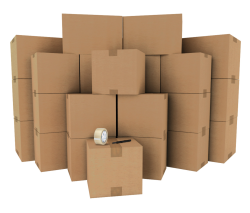 If you’ve ever watched CNBC’s The Profit, you know that many small business owners seem to have the same dreaded psychological disorder: Waste Phobia. To avoid any semblance of waste, products that don’t sell, unused office supplies, outdated equipment and even boxes of permanently-tangled holiday lights all find their way to vast storage areas, where they remain forever.
If you’ve ever watched CNBC’s The Profit, you know that many small business owners seem to have the same dreaded psychological disorder: Waste Phobia. To avoid any semblance of waste, products that don’t sell, unused office supplies, outdated equipment and even boxes of permanently-tangled holiday lights all find their way to vast storage areas, where they remain forever.
With tight budgets, it’s understandable that you don’t want to throw out things that you spent good money on. This is waste, right? But, meaningless storage is wasteful, too. It limits available space for current inventory, it can force your staff to work in sardine-like conditions and it can even clog your mind. Here are 5 possible ways to eliminate some of the waste from unnecessarily-retained items that you can’t seem to throw out and maybe get a bit of a monetary return, as well.
#1. Negotiate a return.
Unless you return items quickly — and the vendor can easily re-sell them — don’t expect a full refund of your purchase price. Still, negotiation is only a phone call away. So, even if you ordered too many custom purple widgets, your vendor might know of another sales opportunity and accept a return for a partial refund. Make sure that your tax-preparer knows the numbers and dates of the original purchase and the return. Any un-refunded value might represent a write-off at tax time.
#2. Find a new way to sell them.
Every new year, Walgreens and countless other businesses cut the prices for holiday items in half. Why spend money on storing them, when gift wrap tends to become yellow and brittle after a year and holiday decorating trends change over time?
Discount-price areas in stores or sidewalk sales are two options for selling products at discount prices. Or, take a lesson from Amazon.com vendors, who often realize greater profits by bundling a number of related inventory items together for marginally-discounted resale. As long as you provide honest value for the price, a less-popular reduced-priced item might create an effective loss leader for the rest of the products in the bundle.
Of course, service businesses do not have as many options in this regard. Few clients would have great confidence in a law firm or accounting office that sells office supplies in the lobby. But, other businesses in your professional network might be very interested in low-cost supplies.
#3. Turn them into something new.
Don’t count on throwing some paint on your unsold inventory of battery-operated rolling plastic penguins and selling them as the new Penguin Plus. But, the drone craze has created customers who are clamoring for anything that flies. Maybe you can add a propeller from your excess inventory to transform this flightless bird into the First Flying Penguin. Of course, do your marketability research to avoid spending more money to create another loss.
#4. Sell them for scrap.
Face it: all-plastic trinkets are worth little as scrap, but certain components within unused items can be valuable. Copper, for example, is a widely-used industrial metal, with per-pound prices that can rise sharply with economic growth. In the 1970s, a pound of copper sold for 50 cents, but in 2000, it spiked 800 percent to $4. Today, copper still goes for more than $2 per pound.
The bottom line is that the components in your unneeded inventory might be worth something. In many cases, a bit of Internet research can tell you if it’s worthwhile to find a scrap dealer.
#5. Donate them.
As a general rule, tossing is easier than donating, but everyone cares about over-crowded landfills. Remember that one person’s trash is another person’s treasure, so the excess bright pink paper that you purchased for promotional posters might be welcomed at a local grade school. The little extra effort spent making a donation is worthwhile based on your good feelings alone, even as your tax-preparer values it as a tax write-off.
The true meaning of waste.
In a perfect world, you avoid waste by buying only the items that you need and immediately using or selling them. In the real world, however, no amount of planning can make that happen. But, retaining unused items is also waste. Even periodic cobweb-cleaning has its costs.
Disposing of unneeded items clears the wasteful cobwebs from your place of business and from your mind, and you can also regain some value through resale or tax reduction. But, recognize the value of lessons learned, as well. Take some time to reflect on what caused the clutter and you’ll reduce waste by making different buying decisions the next time around.

